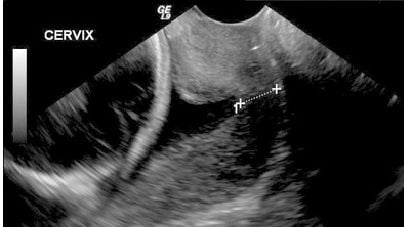Cervical length assessments for the risk of preterm delivery
)
Cervical Length Assessment
The median cervical length at 20 weeks is 42mm, the 1st centile is 23mm. There appears to be value in linking shortened cervical lengths with an increase in the risk of preterm delivery.Cervical lengths of 30mm (10th centile), 27mm (5th centile) and 22mm (2.5th centile) gave relative risks of preterm birth prior to 37 weeks of 3.8, 5.4, and 6.3, respectively, with even greater relative risk at earlier gestations If a transabdominal ultrasound is undertaken and the cervical length is greater than 35mm then this precludes a transvaginal cervical length below 25mm with over 95% sensitivity.
Progesterone Treatment
In 2019 a large metaanalysis demonstrated that progesterone treatment was effective for the prevention of preterm delivery in predisposed women. Vaginal progesterone reduced preterm birth at less than 34 weeks (OR 0.29; 3 studies, moderate-quality evidence), and at less than 37 weeks (OR 0.43, 5 studies, moderate-quality evidence).
Guidelines for Cervical Assessments and Treatment
Current local guidelines include measuring the cervical length at a mid trimester ultrasound scan even in women who are asymptomatic If the cervix is <1.5 cm long and especially if there has been a previous preterm birth prescribe progesterone pessaries 200mg nocte until 34 weeks gestation, delivery or prelabour rupture of membranes If the patient is asymptomatic but has had a prior preterm birth then the cervix should be measured at the 19 week morphology scan and again at 24 weeks .Those whose cervix is <2.5 cm in length should be considered for progesterone pessaries 200 mg nocte until 34 weeks.
| Tags:Obstetrcis |








